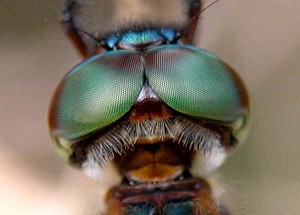Compound Eyes of Insects
Allowing for an incredibly wide viewing angle and the detection of fast movement, compound eyes are highly technical biological structures.
Compound eyes are made up of numerous small optical systems arranged around the outside of a convex surface. There are two different types of compound eye: apposition and superposition. The former is the more common and works by having each photorecepting system (the eye’s ommatidia) independent from every other, each viewing light from just a small part of the overall picture, only to be then pieced together by the brain into a comprehensible whole. This differs from superposition compound eyes where the individual optical systems do not work separately from each other, but rather instead pool their light together to produce one single erect image at the back of the eye.
Indeed, apart from an external aesthetic similarity, with an array of facets positioned around a convex structure, the two compound eye types differ greatly in how they work.
 The main difference is most evident in how the two eyes’ ommatidia process light to form an image. In apposition eyes each ommatidium consists of a thin, tapered tube capped with a cornea, beneath which is a transparent crystalline cone through which rays converge to an image at the tip of its receptive structure, referred to as the rhabdom.
The main difference is most evident in how the two eyes’ ommatidia process light to form an image. In apposition eyes each ommatidium consists of a thin, tapered tube capped with a cornea, beneath which is a transparent crystalline cone through which rays converge to an image at the tip of its receptive structure, referred to as the rhabdom.
Each ommatidium is hexagonal in shape and lined with pigment cells, which act as a light barrier between each tube. Because of this, each ommatidium only receives an incredibly narrow proportion of incoming light from directly in front of it, each contributing a small part of the overall picture.
In superposition compound eyes, however, beneath the optical elements there is a wide transparent clear zone, unimpeded by pigment cells. This means that unlike apposition compound eyes where the ommatidium form small isolated images to be pieced together at the brain, the optical elements in superposition eyes superimpose all light rays received across the ommatidia to form one erect image on a deep-lying retina, only then having the whole image sent to the brain for processing.
 There are benefits of each type of compound eye, compared to each other and standard lens-bearing eyes as sported by humans. The main benefits include a very large viewing angle – due to the convex array – fast movement tracking due to the amount of photorecepting units that do not have to individually move to track, and the ability to detect the polarization of light. However, negatively, because the individual elements are so small, due to the principle of diffraction of light, resolution in compound eyes is considerably worse than in normal variants with large lenses (this is why astronomical telescopes have such large lenses or mirrors). The main benefit of superposition eyes over apposition eyes is their ability to deliver a picture in lower light conditions due to the convergence of gathered light rays.
There are benefits of each type of compound eye, compared to each other and standard lens-bearing eyes as sported by humans. The main benefits include a very large viewing angle – due to the convex array – fast movement tracking due to the amount of photorecepting units that do not have to individually move to track, and the ability to detect the polarization of light. However, negatively, because the individual elements are so small, due to the principle of diffraction of light, resolution in compound eyes is considerably worse than in normal variants with large lenses (this is why astronomical telescopes have such large lenses or mirrors). The main benefit of superposition eyes over apposition eyes is their ability to deliver a picture in lower light conditions due to the convergence of gathered light rays.
Top 5 Facts About Insects Eyes
1.Eye-spy – There are ten eye layouts falling into two categories. Simple eyes have one concave photoreceptive surface, while compound eyes have a number of lenses on a convex surface.
2.Seven – Simple eyes such as those of humans are very common on Earth and have evolved at least seven times from just a small grouping of photosensitive cells.
3.Mosaic – Adult dragonflies can have 30,000 ommatidia, giving them incredibly detailed, mosaic-like images to process. The quantity also grants them excellent movement sensing.
4.Different forms – Compound eyes come in two forms. Apposition eyes work by combining individual points of info together to form an image, while superposition eyes create one whole image.
5.Cambrian – Apposition eyes are almost certainly the original type of compound eye. The oldest eyes found are from the trilobites of the Cambrian Period (542-488.3 million years ago).

